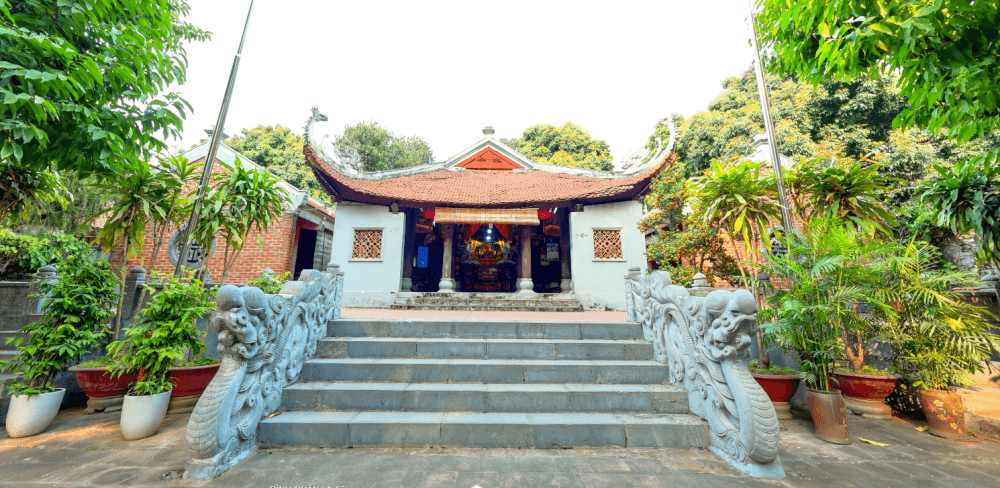

Introduce
Quan La communal house is an ancient name also known as Gia La temple, Khai Nguyen temple, Chua Hang temple and now located in Xuan La Ward, Tay Ho District.
Quan La is located on the mound That Dieu, the center of Quan La village. The communal house consists of three chapels, two halls and a secret harem. Through the construction and layout, the village worshipers of the gods have served with the people of this region. The villagers do not have the god’s legend. At the library there is no theology of Quan La so it is impossible to study the history of gods. Based on the West Lake, it is possible that this was the god who was worshiped at the end of the Tran Dynasty.
There are 18 edicts preserved in the communal house, due to the feudal dynasties decorating the citadel of Quan La village. There are many noble edicts: Thinh Duc 1 (1653), Le Than Tong, (1670) Le Huyen Ton, Duc Nguyen (1674), Vinh Thinh 1 (1705) ... So only the edicts have told us the history of the communal house is very ancient, it must be born sooner the days of honor for the village god we have mentioned above. The edicts stored in the communal house said worshiping the god to the descendants.
“Name for Quan La communal house, Tu Liem District, Hanoi from the past served the context of the Royal Guards pay tuition, pageant spirit. Having been ordained, ordained worship. The 31th year of Tu Duc, right at the time of the royal wedding, gave great grace. The ceremony promoted, especially allows worship as the old to remember the National Day and the worship tradition.”
God is responsible for protecting the nation and the people. The village god of Vietnam is generally responsible for that task.
The architectural elements of the communal house are arranged in depth, in a spacious and quite completed form, including garden, three-arched-gate entrance, and courtyard: In front of the old three-arched-gate entrance is a spacious space with brick village road with lots of ancient trees surrounding. Just close to the east side of the communal house is a large tree, with a diameter of 1m50, this plant is planted on a mountain, the body of the tree look strange. The plant is tall, canopy, but each year only 1, 2 fruits. Legend has it that hundreds of years, and villagers often also worship the two maids of Mrs. Due Trang who is the village god in the tree, it is sacred ... today people have built a small shrine right at the root to worship the two women and call shrine Chau ba.
On the west side of the communal house is a tree that has many ancient roots which may be several hundred years old. In the days of resistance against French colonialism, the banyan tree in front of the communal house was the place of operation of the revolutionary soldiers.
When the country was peaceful, President Ho Chi Minh came to visit Quan La communal house for the first time in the movement of agricultural cooperation. On November 23, 1958, standing under the ancient tree in front of the house, Uncle Ho instructed the people and cadres of Quan La village commune. "This ancient tree as well as the house is a place of historical relics with high value, elders and all Quan La people must keep good protection. On November 23, 1964 after 8 years, Uncle Ho returned here to visit the house and Quan La people. On the anti-American resistance days, Quan La communal house was the headquarters of the units guarding the capital.
Main temple: From the court we step up 5 steps to the courtyard with the two sides of the door to add two dragon parallels to welcome the guests, step through a door to enter the communal house.
Quan La communal house is built in the direction of South to West, this is an unique characteristic of this communal house, with this feature we see very little in the North of Vietnam but only in the South. In the North, the communal house had the head turned out only in Son Dong, Nghe Tinh. Especially in the main temple, there are one parallel sentences for those who call it a very special writing.
The harem has the altar in the middle with the worship items outside, the throne, the tablet of worshiping the god of the village is placed in the most important position in a large space with glass. Behind the back of the harem, in the background is an ancient cave.
It is worth noting that behind the harem, the cave was rebuilt from the Ly dynasty called Thong Thien cave. The theory is that this is the tunnel of the Tao. According to the initial assessment of Professor Ha Van Tan, this may be the tomb in the Han Dynasty. In fact, in the area of Quan La, Xuan Tao, Chem Ve, some archaeological studies have discovered many tombs in the Han and Luc Dynasty.
The civil and military mandarin’s house: This house has a structure with hidden-foot pillars and large cross beams that run the length of the house. The interconnecting bays are supported by upper and middle crossbeams, which serve as the main supports for the structure. This is the place where two clans in the village come to perform their religious rituals.
Quan La Communal house and Khai Nguyen Pagoda have a long history spanning millennia in an ancient area of the relics of the ancient villages: Thien Nien Pagoda, Vong Thi Pagoda, Van Nien Pagoda, Uc Nien Pagoda... In a region with traditional culture and traditions against foreign invaders a long time ago, there are many values of ancient history, revolutionary history of resistance and modern, high value of architecture technology together with a beautiful landscape has blended together, experiencing many different periods of history, the communal house is a place to witness and contribute to the common history of the nation.
With the existing values, the relics of the communal house and Quan La Pagoda are classified as historical architectural art and landscape. The relic was classified by the Ministry of Culture and Information on 31 January 1992./.
Artifacts
Map
Nearby Places
No. 43C, alley 497, quarter 2, group 15, Lac Long Quan Street, Nhat Tan Ward
0.65Km
No.6, Lane 319, An Duong Vuong Street, Phu Thuong ward
2.22Km
Lane 242, Lac Long Quan Street, Buoi Ward, Tay Ho District, Hanoi.
No. 20, Lane 472, Cluster 3, Lac Long Quan Road, Nhat Tan Ward, Tay Ho District, Hanoi.
No. 35, Lane 416, Lac Long Quan Road, Nhat Tan Ward, Tay Ho District, Hanoi.
2.14Km
No. 07, Lane 30, Tay Ho Road, Quang An Ward, Tay Ho District, Hanoi.
1.86Km
Residential Area No. 5 (No. 3, Lane 200, Au Co Road), Tu Lien Ward, Tay Ho District, Hanoi.
2.44Km
Residential Area No. 5 (No. 3, Lane 200, Au Co Road), Tu Lien Ward, Tay Ho District.
2.5Km